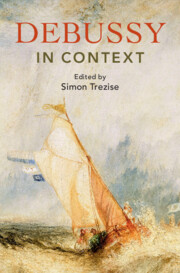Refine search
Actions for selected content:
44 results
9 - Performing the Barline in Debussy’s Music
- from Part III - Performance
-
-
- Book:
- Debussy Studies 2
- Published online:
- 15 November 2025
- Print publication:
- 06 November 2025, pp 209-235
-
- Chapter
- Export citation
4 - The Young Debussy Reconsidered through his Early Chamber Music
- from Part II - Analysis
-
-
- Book:
- Debussy Studies 2
- Published online:
- 15 November 2025
- Print publication:
- 06 November 2025, pp 89-111
-
- Chapter
- Export citation
6 - ‘Rhythmicised Time’ in Debussy’s Settings of ‘En sourdine’
- from Part II - Analysis
-
-
- Book:
- Debussy Studies 2
- Published online:
- 15 November 2025
- Print publication:
- 06 November 2025, pp 146-162
-
- Chapter
- Export citation
Chapter 10 - Brahms According to Schoenberg According to Boulez
- from Part II - Musical Modernism
-
-
- Book:
- Boulez in Context
- Published online:
- 08 July 2025
- Print publication:
- 24 July 2025, pp 93-100
-
- Chapter
- Export citation
Chapter 7 - Boulez and Debussy
- from Part II - Musical Modernism
-
-
- Book:
- Boulez in Context
- Published online:
- 08 July 2025
- Print publication:
- 24 July 2025, pp 69-75
-
- Chapter
- Export citation
Chapter 30 - Boulez on Record
- from Part V - Multiple Activities
-
-
- Book:
- Boulez in Context
- Published online:
- 08 July 2025
- Print publication:
- 24 July 2025, pp 312-319
-
- Chapter
- Export citation
Chapter 18 - Boulez and His ‘Useless’ Contemporaries
- from Part III - Engagements with the Post-War Generation of Composers
-
-
- Book:
- Boulez in Context
- Published online:
- 08 July 2025
- Print publication:
- 24 July 2025, pp 186-199
-
- Chapter
- Export citation
Chapter 31 - Pierre Boulez at the BBC
- from Part V - Multiple Activities
-
-
- Book:
- Boulez in Context
- Published online:
- 08 July 2025
- Print publication:
- 24 July 2025, pp 320-326
-
- Chapter
- Export citation
2 - From Space to Sound
- from Part I - Creative Processes
-
-
- Book:
- The Cambridge Companion to Composition
- Published online:
- 25 May 2024
- Print publication:
- 30 May 2024, pp 32-41
-
- Chapter
- Export citation

Debussy in Context
-
- Published online:
- 23 May 2024
- Print publication:
- 23 May 2024
Chapter 11 - Cross-Currents in Debussy’s Creative World
- from Part II - The Arts
-
-
- Book:
- Debussy in Context
- Published online:
- 23 May 2024
- Print publication:
- 23 May 2024, pp 106-114
-
- Chapter
- Export citation
Chapter 24 - Ballet and Dance
- from Part V - The Music of Debussy’s Time
-
-
- Book:
- Debussy in Context
- Published online:
- 23 May 2024
- Print publication:
- 23 May 2024, pp 220-229
-
- Chapter
- Export citation
Chapter 10 - Japonisme, Collecting, and the Expositions Universelles
- from Part II - The Arts
-
-
- Book:
- Debussy in Context
- Published online:
- 23 May 2024
- Print publication:
- 23 May 2024, pp 98-105
-
- Chapter
- Export citation
Chapter 2 - Paris and the Nation’s Politics
- from Part I - Paris: City, Politics, and Society
-
-
- Book:
- Debussy in Context
- Published online:
- 23 May 2024
- Print publication:
- 23 May 2024, pp 16-24
-
- Chapter
- Export citation
Chapter 12 - Debussy and the Family in Third-Republic France
- from Part III - People and Milieu
-
-
- Book:
- Debussy in Context
- Published online:
- 23 May 2024
- Print publication:
- 23 May 2024, pp 117-125
-
- Chapter
- Export citation
Chapter 23 - Composing for Opera and Theatre outside Established Genres
- from Part V - The Music of Debussy’s Time
-
-
- Book:
- Debussy in Context
- Published online:
- 23 May 2024
- Print publication:
- 23 May 2024, pp 211-219
-
- Chapter
- Export citation
Chapter 14 - Relationships with Poets and Other Literary Figures
- from Part III - People and Milieu
-
-
- Book:
- Debussy in Context
- Published online:
- 23 May 2024
- Print publication:
- 23 May 2024, pp 135-142
-
- Chapter
- Export citation
Chapter 19 - Parisian Opera Institutions: A Framework for Creation
- from Part IV - Musical Life: Infrastructure and Earning a Living
-
-
- Book:
- Debussy in Context
- Published online:
- 23 May 2024
- Print publication:
- 23 May 2024, pp 177-184
-
- Chapter
- Export citation
Chapter 27 - Song and Choral Music
- from Part V - The Music of Debussy’s Time
-
-
- Book:
- Debussy in Context
- Published online:
- 23 May 2024
- Print publication:
- 23 May 2024, pp 248-257
-
- Chapter
- Export citation
Chapter 32 - Debussy Today
- from Part VI - Performers, Reception, and Posterity
-
-
- Book:
- Debussy in Context
- Published online:
- 23 May 2024
- Print publication:
- 23 May 2024, pp 299-310
-
- Chapter
- Export citation
